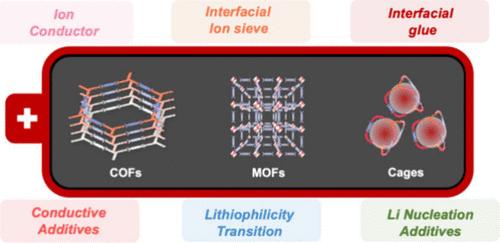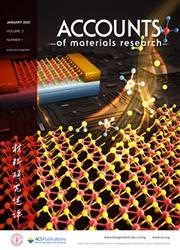Porous Crystalline Frameworks as Ion-Conducting Solid-State Electrolytes
IF 14
Q1 CHEMISTRY, MULTIDISCIPLINARY
引用次数: 0
Abstract
Room-temperature Li+ conductors have been intensively revisited to develop high-safety solid-state batteries. While promising inorganic Li+ solid-state electrolytes (SSEs) with competitive ionic conductivity have been demonstrated, their practical applications are still hindered by manufacturing technology, cost constraints, and internal battery interfaces. Advances in the design and synthesis of periodic frameworks over the past decade have created a new platform for designing SSEs. These porous crystalline frameworks feature open channels that can be tailored into ion-hopping sites and guest-accessible voids, both essential for SSE construction. Framework-based SSEs uniquely merge the advantages of inorganic crystal-like ordered structures and the design flexibility of organic molecules, distinguishing them significantly from traditional inorganic or organic SSEs. Enhancing ionic conduction and exploring potential applications are two critical factors driving the rapid advancement of framework-based SSEs.

作为离子导电固态电解质的多孔晶体框架
为了开发高安全性固态电池,人们对室温 Li+ 导体进行了深入研究。虽然具有竞争性离子电导率的无机 Li+ 固态电解质(SSE)已经得到证实,但其实际应用仍然受到制造技术、成本限制和电池内部接口的阻碍。过去十年间,周期性框架的设计和合成技术取得了进步,为设计 SSE 创造了一个新平台。这些多孔晶体框架具有开放的通道,可以定制成离子跳跃位点和客体可进入的空隙,这对于 SSE 的构建都至关重要。基于框架的固态电子器件独特地融合了无机晶体有序结构的优势和有机分子设计的灵活性,与传统的无机或有机固态电子器件有着显著的区别。增强离子传导和探索潜在应用是推动基于框架的 SSE 快速发展的两个关键因素。
本文章由计算机程序翻译,如有差异,请以英文原文为准。
求助全文
约1分钟内获得全文
求助全文

 求助内容:
求助内容: 应助结果提醒方式:
应助结果提醒方式:


